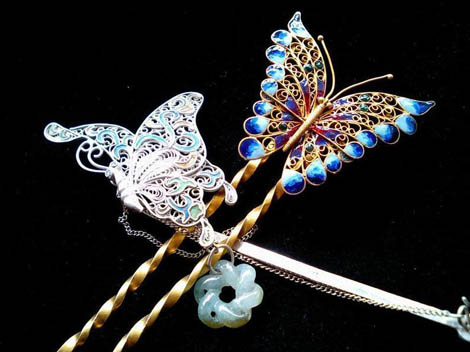
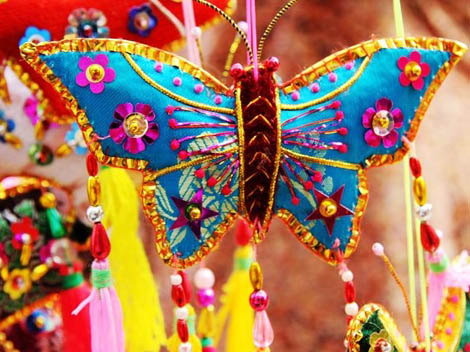
In ancient China, engagement was an important social rite where man and woman confirm marital ties, next only to official marriage in significance. Marital ties were made by following "parents' order and on the matchmaker's word". However, maidens in the age of adolescence had the tradition of pledging in love with tokens of love. Under the pressure of the society, young men and women would deliver tokens of love in private. Others just could not tell.
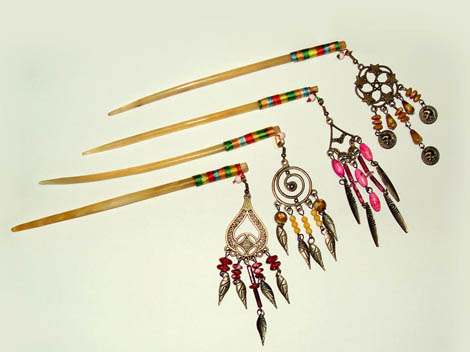
The ancient tokens of love largely comprise bracelets, arm-wrapped gold, finger rings, earrings and perfume satchels. They might also be some small articles handed down from ancestors, or souvenirs meticulously chosen. No matter what they are and how valuable they might be, tokens of love always have some origins or become closely associated with the people. The spiritual implications of the tokens of love will surely not be weighed by their monetary values. Presenting tokens of love is just like submitting one's aspirations, showing the persons they will be loyal for life.
1.Bracelet
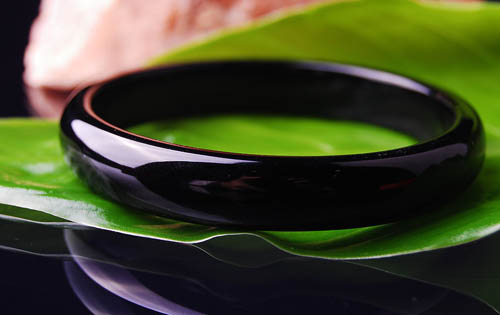
The time-honored bracelets could be traced back to the period when the matrilineal society started to transit to the patrilineal society. Archaeologists have found pottery and stone bracelet-like rings, which ancient people applied to decorate their wrists, at the Banpo Site (a Neolithic site of the Yangshao Culture at Banpo Village on the eastern outskirts of Xi'an) about 6,000 years ago and at the Xixiahou Neolithic Age Site of Qufu, Shandong Province. As shown in the unearthed bracelets, they were made of animal bones, teeth, stones and potteries. The bracelets are in the forms of circular tubes, circular rings, or combined by two semi-rings.
In the Sui(AD581-618), Tang (AD618-907) and Song (960-1279) dynasties, it was very popular for women to decorate their arms with bracelets, known as armlets. The images of women wearing armlets are found in Taizong Meeting Tibetan Emissaries of Yan Benli and Court Ladies Adorning Their Hair with Flowers of Zhou Fang, painters of the early Tang Dynasty. Such decorations went beyond royal families and aristocrats. Common people also crazed about them. As historical records showed, Cui Guangyuan, a Tang Dynasty general, led troops to suppress Duan Zizhang, a rebel. The soldiers of Cui robbed people everywhere and cut the arms of women for taking away armlets. It suggested there were many women wearing armlets at the time.
After the Tang and Song dynasties, bracelets were made of better materials and techniques. There emerged gold and silver bracelets, jade-embedded bracelets, and precious stone-embedded bracelets. They were processed into the shapes of circular rings, stringed beads, twisted threads, braids and bamboos. When it came to the Ming and Qing dynasties and the Republic of China period, gold bracelets embedded with precious stones turned most popular. They were improved significantly in modeling and processing techniques.
Although bracelets were decorations on arms, they were the earliest evidence of people's indistinct yet inherent love of beauty. Many scientists argue that bracelets came forth not because of the love of beauty. Instead, they were associated with totem worship and witchery rituals. Some historians say that since men assumed absolute rule in economic life, they cultivated the barbarian customs to tie down women with finger rings and bracelets. Such a metaphor existed for quite a long time.
2.Arm-wrapped gold
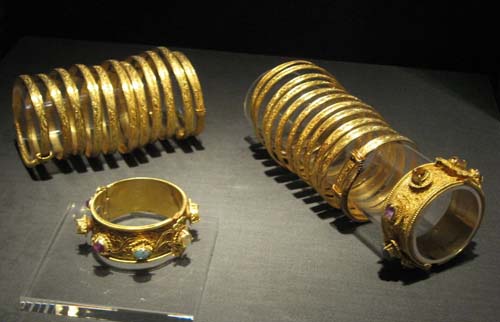
In the early days, armlets largely appeared in North China areas, where people had gold bars or silver bars hammered flat, and coiled them in screw loops. The loops might diversify from three circles to five circles and even eight circles. They were separated into the decorated type and plain type. Those engraved with decorative patterns were called decorated bracelets, and those without decorative patterns were called plain bracelets. No matter what angles they are observed, they present several rounds of circular rings, as if the women wear a number of bracelets. In pictograph, the Chinese character for bracelet comprises gold and river.
3. Finger ring
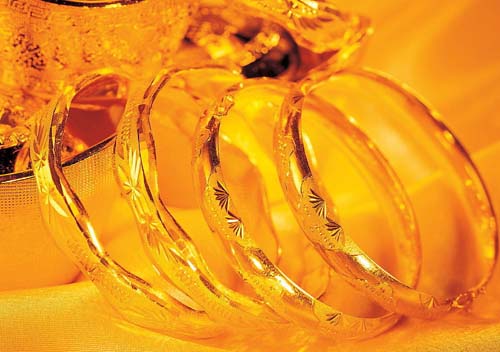
In ancient days, unmarried women would not wear any finger rings, because finger rings were tokens of marital ties or tokens of love. This token, smallest compared with other tokens, was yet the heaviest in the mind of women. This remains true up to these days. Offer your hand, and the man on your opposite will wear the ring for you. After that, you might live happily with it all your life, or weep upon it with broken heart some day.
There is a story in Taiping Era, in which Li Zhangwu, a scholar, fell in love with Wang Zifu, a woman from Huazhou. When they parted, Wang presented Li a white jade finger ring, and inscribed a poem, "Twist the finger ring I am lovesick at heart, How I miss you with the ring at my side. Hope you hold and enjoy it forever, all in an ending cycle never." Many years later, Li retuned to Huazhou, finding that Wang had died of profound melancholy. The two finally met in Wang's house in a dream.
Discussions with Friends in Cloud Village presented a love story between Wei Gao and Yuxiao. Distressed at parting, Wei sent a jade finger ring to Yuxiao, pledging to return and marry her in five to seven years. But Wei broke his promise and Yuxiao fasted and died. Later when Wei took the post of Xichuan governor, he heard of the news and lamented. He had a lot of figures of Buddha built to atone for his crime. In the end, Yuxiao was reincarnated as a singing girl and returned to the side of Wei to renew the previous love story.
4. Earrings
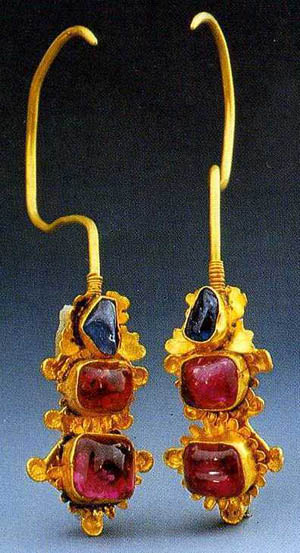
Chinese women began to dress themselves with all sorts of earrings long ago. The earliest record of this tradition appeared in the Mountain and Sea Bible, in which "A pleasant maiden from Qingyi Mountain, with thin waist and white teeth, has her ears pierced for earrings." Zhuge Ke said in The Records of Three Kingdoms that "it is a fashion since ancient times to pierce earlobe for pearl decorations." It shows wearing earrings was a fashion since the three ancient Chinese dynasties——Hsia, Shang and Chou. Earrings comprise earbob, ear-ornaments, and ear drops. Li Liweng, a scholar of early Qing Dynasty, called small and exquisite earrings "clove", and heavy and gorgeous earrings Luosuo in his Idle Feelings Randomly Recorded. He said "one hairpin and earrings would accompany women all her life." It shows how important earrings were in the aesthetic concepts of ancient people.
Zhang Ji, a poet of the Tang Dynasty, wrote in his poem Reply of a Chaste Wife that "So I know return your tow shining pearls with a tear on each, Regretting that we did not meet while I was still unwed." The "shining pearls" exactly refer to earrings. Isn't it true that earrings pass through sadness as tokens of love? Zhang Huilian, of late Yuan Dynasty, mourned for her deceased husband in a Bamboo Branch Gamut poem, highly likely a result of seeing a thing and thinking of the person, "I recall you bought me shining pearls, I got up combing hair and darkening eyebrows. Where are you my love, I sit lonely dread to see twin butterflies."
After the Jinkang Crisis of the Song Dynasty, Emperor Huizong sent Cao Xun, an official, to flee back to the area under the Southern Song regime, in the hope that Zhao Gou, his son who succeeded the throne, would save his life with troops. Cao Xun brought along personal belongings of some close kin of Zhao Gou, as evidences. One of them was an earring of Zhao Gou's wife. When Zhao Gou was Prince Kang, he was in deep love with his wife. The earring might evoke passions of Zhao Gou, seeking momentary ease, to save his kinsfolk out of tribulation. However, the country and family had experienced radical changes. Emotions would change along with actual situations. Zhao could not take back half of his country, not to mention a wife "having lost her chastity". The piteous princess had to keep the other earring and live the rest of her life hopelessly in tears.
5. Perfume satchel
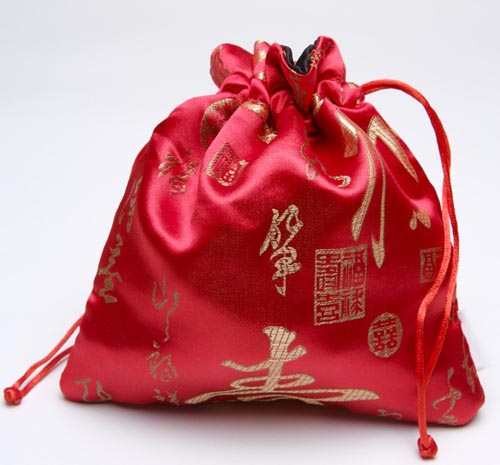
There is a long history about the use of perfume satchels. Perfume satchels were also known as sachets, perfume tassels, perfume bags, perfume balls, rubando and pouches. Perfume satchels could be dated back to the pre-Qin period. According to The Book of Rites. The Pattern of the Family, "Sons, in serving their parents, From the left and right of the girdle, they should hang their articles for use;... They should all bang at their girdles the ornamental (bags of) perfume …. Thus dressed, they should go to their parents and parents-in-law." In other words, when young fellows went to see their parents and the elders, they had to wear "the ornamental (bags of) perfume", or woven perfume bags, to show respect. Since perfume satchels are personal belongings, lovers will present them to each other as gifts, to express their inner feelings.
When An Lushan and Shi Siming, generals of Tang Dynasty, raised a rebellion in the Central Plains in 755, Emperor Xuanzong fled with Yang Guifei, a magnificent concubine, to the West. When the troops arrived at Maweipo, the soldiers stopped, demanding to have Yang Guifei, the femme fatale, killed. The emperor gave in, letting Yang to assume by herself the blame for the chaos of war. Yang was hanged and buried in a hurry. When the capital was recovered later, Emperor Xuanzong silently had her body re-buried. The eunuch handling the mission found that the concubine's tomb was left only with white bones, except for the perfume satchel intact in the bosom. He fetched the perfume satchel and brought it back to the emperor. The abdicated emperor, into senility, saw the perfume satchel and was reminded of the owner. The glees of singing and dancing at the Lishan Palace had elapsed, leaving only the perfume satchel to remind the deep love of old days. He put the perfume satchel into his sleeve, bursting into tears. Eighty years later, Zhang Hu, a poet, sighed with feelings, and wrote down the poem Taizhen Perfume Bag, in which "Gold thread embroidery and small perfume bag, leave sweet-smelling to the princess at the bosom sad. Who will unbind it for the emperor, eternal regret tie the state of mind."
No one could untie the small perfume satchel for Emperor Xuanzong. Was it love or hate? Who knows it, except for Yang, the owner?
Chronicles of the Jin Dynasty Biography of Jia Wu recorded a love story between Jia Wu, the youngest daughter of Jia Cong, a favorite official of Emperor Wudi of Jin Dynasty, and Han Shou, an assistant to Jia Cong. In a lovers' rendezvous, Jia Wu gave Han some spice from the Western Regions. Han's aroma was soon smelled by Jia Cong. He guessed out the story. He did not blame his daughter, but married her to Han instead. This turned into a story on everybody's lips. The spice from the Western Regions should have been put in a perfume satchel made by Jia Wu herself, to match her deep affection as a maiden.
In A Dream of Red Mansion, Lin Daiyu sewed a perfume satchel, stitch by stitch, for Jia Baoyu. It was a symbol of her affections. One day, Lin misunderstood that Baoyu gave the perfume satchel to others. Feeling wronged, she cut into pieces another perfume satchel she was sewing in hand. The perfume satchel was worn by Baoyu next to the skin. How could he send it to others? When the fragrance-like Lin deceased, Baoyu could not bear to see the perfume satchel any more.
6. Jade pendant
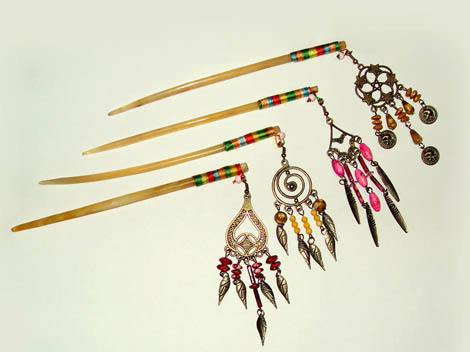
Chinese people were fond of jade in the ancient time. There is an old saying that "Men of honor will keep jade with them, and with reasons." Letters on Ancient Poems explains that "Decorating tassel with jade symbolizes knot of love." Luoying was a colorful silk belt tied by women in the ancient when they got married, showing they were affiliated with their husbands. Jieli was another term in the old days to describe people getting married. There is a line in The Book of Songs, "When a daughter gets married, the mother would remind her again and again to keep fine appearances." It depicted the scene that when a daughter was married, the mother was reluctant to part the daughter, whispered to her, while helping her bind up the silk tassel.
7. True lover's knot
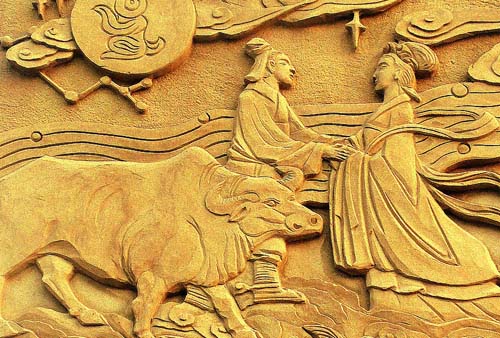
Sources of Poems had a story in which Wen Zhou fell in love with his neighbor Miss Jiang. He sent her a crystal pin as a token of love. Miss Jiang opened up her workbox, fetched twin threads, threaded them into a twin needle, and wove a true lover's knot to return it to Wen. Plain threads imply purity, while needle sounds the same as chastity in Chinese.
Weave a brocade belt into a circular true lover's knot and return it to the lover, It has contained all the unbroken love and passions. Xiao Yan, who was Emperor Wudi of Liang Dynasty, wrote a poem with the lines "dual-Yee waist belt, dream for the end of one mind." Lin Bu, a poet of the Song Dynasty, left us a Ci-poem reading "Tears from your eyes, tears from mine eyes, could silken girdle strengthen our heart-to-heart ties? O see the river rise!"
Words are the voice of the mind, as in the lines "heaven is forever young, love never gives up, my heart is bound like a net, with thousands of knots inside." The Chinese word "knot" was simply like a net "bear in mind constantly, fasten the emotions with knots." However, it could not catch all in one draft the stories of the idiotic lovers in the world. We could only witness the sight with dismay.
8. Hairpin
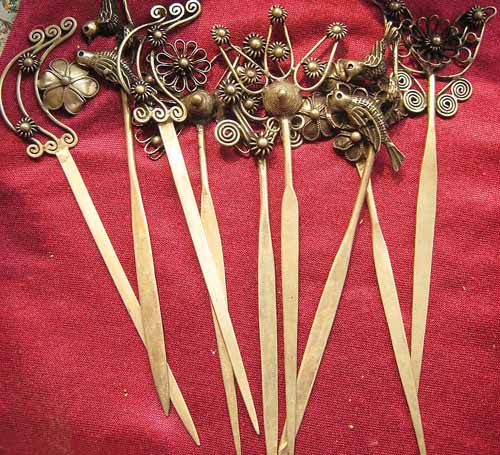
Hairpin is a long needle used by ancient people to fix wispy bun or fasten a hat with the hair. It was later exclusively applied to refer to an ornament of women for fixing wispy buns. As shown in Historical Records•The Jesters, "there are sinking earrings in the front and hairpins at the back." Du Fu also left us a line in Spring View that "I stroke my white hair.It has grown too thin To hold the hairpins any more."
China's ethnic minorities have the tradition of using hairpins to fix up hair and make hairdressing. Their hairpins are of diversified varieties, with long histories and rich national features and cultural implications.
In the Tang, Song and later dynasties, hairpins became increasingly popular. Women in the Dunhuang frescoes of the Tang Dynasty were decorated with all kinds of charming hairpins. Paintings of the Tang Dynasty were also permeated with women wearing hairpins. Chronicles of the Song Dynasty.Records of Traveling presents that "At the sixth year under the reign of Emperor Yuanjia of Song Dynasty, women in the society would knot their hair…. Their heads are decorated with pattern-based hairpins." Lu You, a poet of the Song Dynasty, wrote in Story about Going to Sichuan that women of Southwest China bore headwear comprising "six silver hairpins, backed with elephant tooth comb as large as hand."
During the Ming (1368-1644) and Qing (1644-1911) periods, hairpins presented multiple styles, featuring great many changes at the tip of hairpins. The most popular forms included flowers, birds, fish, insects and beasts. The frequently borrowed flowers were plum blossoms, lotus flowers, chrysanthemums, peach blossoms, peonies and lotuses.
Hairpins were favorites of men when they present gifts to their lovers. Women often took them as tokens of love for their boyfriends. Many miserable love stories took place, simply because of one hairpin. The currently popular hairpins almost fully duplicate the ancient ones in external looks and materials. Gold and silver hairpins remain the best loved for women these days.
9. Twin-hairpins
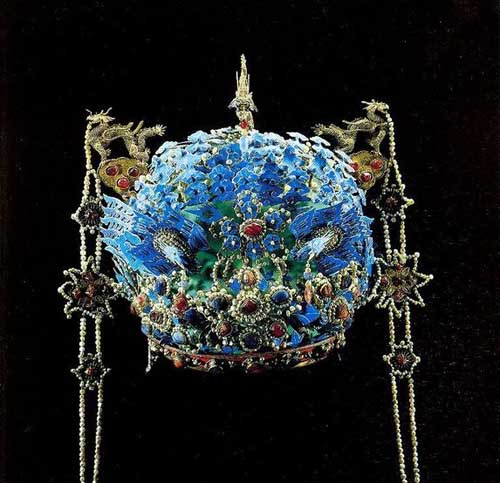
Twin-hairpins are largely flower-shaped ornaments made of pearls, jade, gold or silver. They are connected with two or more long needles to fix up wispy buns of hair. They are inserted to the side of the temples.
Twin-hairpins are not only ornaments. They are objects expressing loves. When lovers or couples parted in the old days, the women would pick up twin-hairpins from the hair, presenting one to her lover or husband while keeping the other with herself, till they were reunited. Xin Qiji wrote in his Ci-poem Near Zhu ying tai. Late Spring that "The precious hairpin is open, besides the peach ferry, willow mist darkening the eastern beach." It expressed her reluctance to part. Nalan Xingde also expressed similar pains of parting with the beloved in a Ci-poem, reading "Separated are the precious twin-hairpins, I wet my garment to win fate with you."
10. Skirt
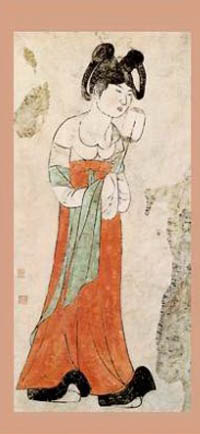
"Whereto answer the exultation? Three white fine skirts."
In ancient China, thin silk was referred to as Wan Su (white, fine gauze), while skirts were developed from Chang. Ancient cloth and silk fabrics were narrow in breadth. One skirt would be made by putting together a number of fabrics. Thus, there came the term Qun (skirt), a homophone of "many", as illustrated in Explanation on Names • Explanation on Clothes, by Liu Xi of Han Dynasty. Xin Yannian, a poet of Han Dynasty, wrote in his poem Captain of the Guard that "In a long gown with double girdle, Wide sleeves and a jacket with mimosa design."
"I feel chaos in the world to see red turn green, wan and sallow I remember you of fond. Refuse to believe I shed tears, open the case I take megranate skirt." The most heart-warming poem on skirts was As One Wishes, composed by Wu Zetian, China's only empress in history. For whom did she write the poem? For herself! They might be as heroic as Wu Zetian, but women in this world would equally feel tired in the human society. When they saw cherry bays under moonlight, they also had no way to flee from longing and languish in the long night….
People prefer to witness their love with tokens of love. Each token is endowed with loyal faith in love. Some of the tokens of love as mentioned above have stood apart from our present lives. Some others remain delivering passion among lovers.





